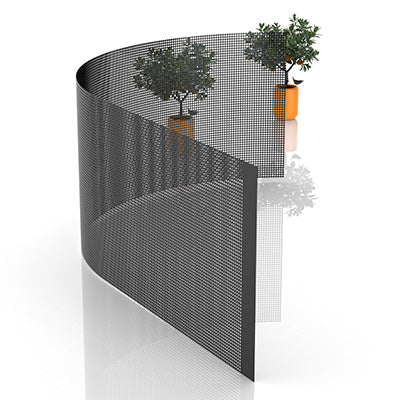In today’s fast-paced digital era, visual display has become the core of brand communication. Traditional flat displays, LCD screens, and printed posters still dominate many venues, but their limitations in creativity and spatial expression are becoming increasingly apparent.
Now, a new generation of display technology — the Flexible Holographic LED Screen — is breaking through the boundaries of flat surfaces. With its unique flexibility, transparency, and futuristic visual appeal, it is redefining how businesses showcase their products and engage audiences.
1. What Is a Flexible Holographic LED Screen?
A Flexible Holographic LED Screen, also known as a flexible transparent LED display, combines high transparency, bendable structure, and ultra-thin design. Unlike traditional rigid LED modules, it uses flexible PCB or silicone light-strip substrates, allowing it to bend freely into curves, waves, or cylindrical shapes.
When turned off, it appears nearly invisible with a transparency rate of 70%–90%; when powered on, it delivers vivid, floating visuals. This duality makes it an ideal solution for storefronts, art installations, exhibition halls, stage designs, and high-end commercial spaces.
2. Breaking Flat Boundaries: The Power of Flexibility and Holography
1. Flexible Design Enables Spatial Creativity
The flexible structure frees designers from the constraints of flat surfaces. Screens can be shaped around glass facades, columns, ceilings, or suspended structures, allowing displays to blend seamlessly with architecture and interior design.
This versatility creates immersive, three-dimensional effects that attract attention and elevate brand presence.
2. Holographic Visuals for a Futuristic Experience
While not true holographic projection, the transparent grid and floating imagery of flexible LED screens produce a stunning “suspended” illusion.
Viewers perceive visuals as floating mid-air — blending reality and virtuality — which gives retail and stage environments a captivating futuristic feel.
3. Invisible Aesthetic Integration
When not illuminated, the transparent LED mesh becomes nearly invisible, maintaining natural lighting and visual openness. Compared with traditional opaque LED walls, this technology allows for hidden displays that merge naturally with modern architectural aesthetics.
3. Commercial Applications: Where Technology Meets Art
The value of flexible holographic LED screens extends far beyond aesthetics — they reshape the logic of commercial presentation.
-
Retail Windows & Brand Displays
In flagship stores, shopping malls, and showrooms, flexible holographic screens replace traditional posters with dynamic, motion-based storytelling.
For example, a car brand can project a floating vehicle animation on its glass façade — retaining interior visibility while adding futuristic visual effects. -
Stage and Exhibition Art Installations
For concerts and immersive exhibitions, flexible holographic screens integrate with lighting and audio systems, forming a three-dimensional visual environment. Their ability to bend and wrap around the stage creates a “surround display” that captivates audiences. -
Corporate Lobbies & Technology Centers
In corporate or museum environments, flexible holographic displays create interactive storytelling spaces, presenting brand messages, data, and visuals in a sleek, high-tech form. -
Architectural Facades & Ambient Design
Lightweight and ultra-thin, flexible holographic screens can be mounted directly on glass or metal surfaces, transforming building exteriors into glowing art installations without structural modification.
4. Core Technologies: Structural and Performance Innovations
-
High Transparency & Balanced Brightness
Using transparent LED light-bar technology, these screens achieve 70%–90% transparency while maintaining high brightness (4000–5000 nits), ensuring vivid visibility even under daylight. -
Bendable Modular Design
Flexible modules can curve both horizontally and vertically with a radius below 1000mm, supporting multiple creative installations with precise, seamless connections. -
Lightweight and Easy Maintenance
With a thickness under 5mm and weight one-third that of conventional LED panels, flexible screens support magnetic installation and quick module replacement for effortless maintenance. -
Energy Efficiency and Safety
Low-power drivers and heat-resistant materials ensure stable operation in high-traffic commercial environments, combining performance with reliability.
5. Key Advantages at a Glance
| Advantage | Description |
|---|---|
| Design Freedom | Flexible, customizable, and shape-adaptable for creative applications |
| Transparency & Thinness | High transparency without blocking light or views |
| Strong Visual Impact | Floating “holographic” visuals and spatial immersion |
| Easy Installation | Magnetic modular structure allows fast setup and dismantling |
| High Brightness, Low Power | Clear even in daylight while remaining energy-efficient |
| Versatile Applications | Ideal for retail, stage, exhibition, and architectural design |
6. Recommended Products and Application Scenarios
If you’re looking for flexible, transparent LED solutions that combine creativity with performance, the following models are ideal for different commercial environments:
| Product Name | Key Features | Brightness | Application | Learn More |
|---|---|---|---|---|
| P6.25 Flexible Holographic LED Screen | High transparency, bendable modules, suitable for large-scale setups | 5000 nits | Shopping malls / Stage installations | View Details |
| P3.91 Flexible Holographic LED Screen | Higher pixel density for sharper visuals | 4000 nits | Showrooms / Glass display windows | View Details |
| Transparent Holographic LED Film Display (1×2m) | Ultra-thin adhesive film design for seamless installation | 4000 nits | Retail storefronts / Indoor displays | View Details |
| Transparent Holographic LED Film Display (2×2m) | Large-size format for wide-angle visibility | 4000 nits | Flagship stores / Art installations / Corporate lobbies | View Details |
Conclusion: The Future of Visual Marketing Starts with Flexibility
The rise of flexible holographic LED screens represents more than just a technological upgrade — it’s a revolution in visual storytelling.
By freeing displays from flat, rigid boundaries, brands can communicate their message in more immersive, engaging, and artistic ways.
As transparent and flexible display technologies continue to evolve, they will become a defining feature of future storefronts, urban landmarks, and digital art spaces.
From flat to spatial, from static to immersive — flexible holographic LED screens are shaping the next era of visual marketing.

